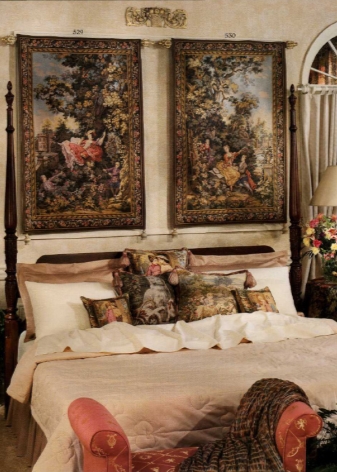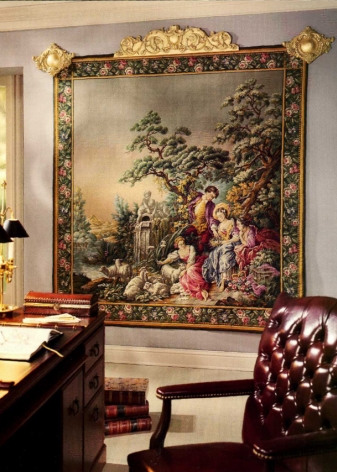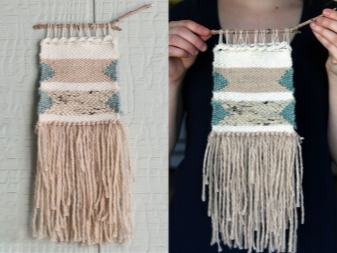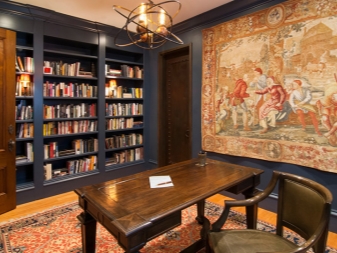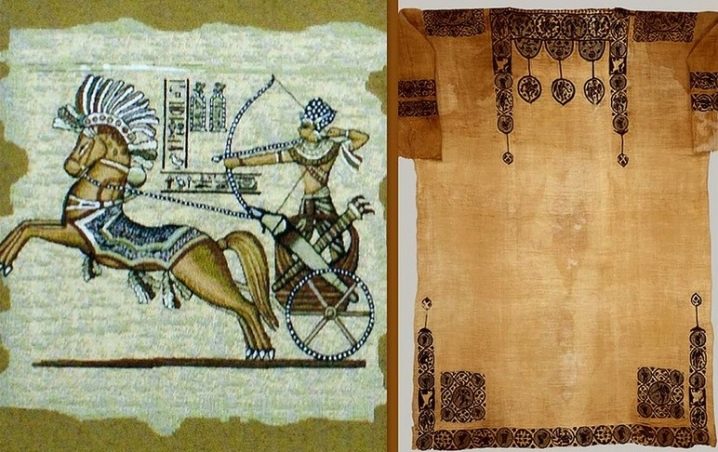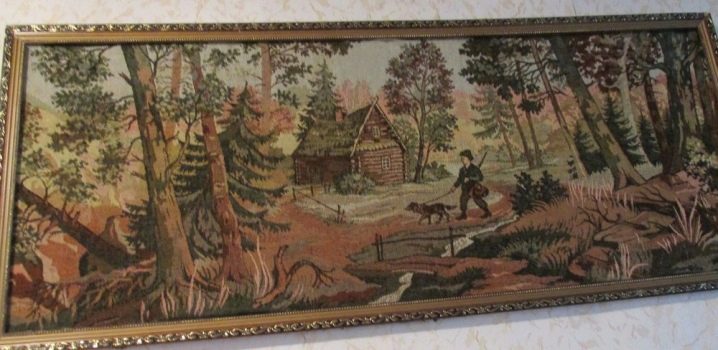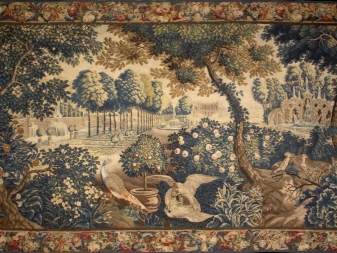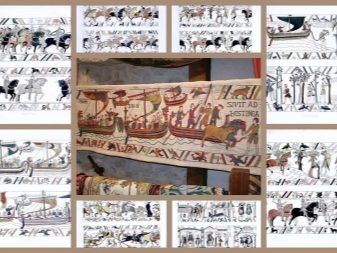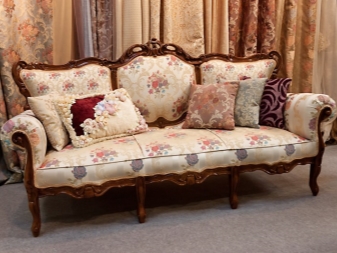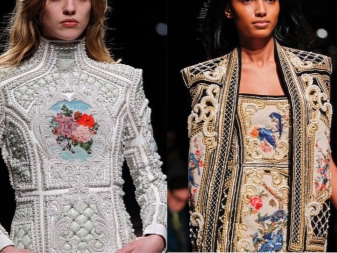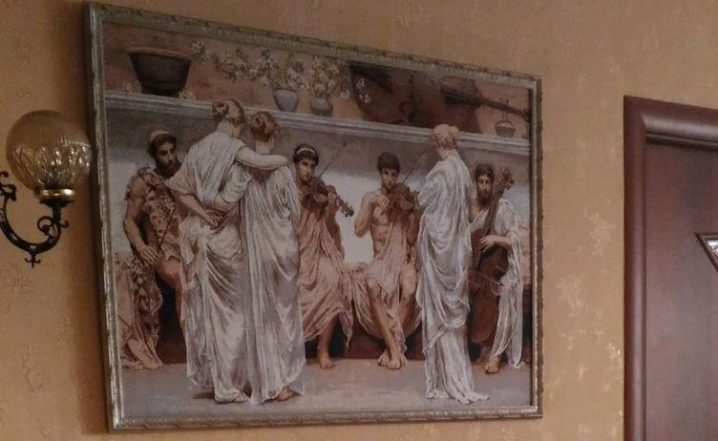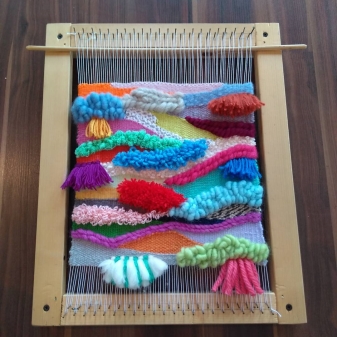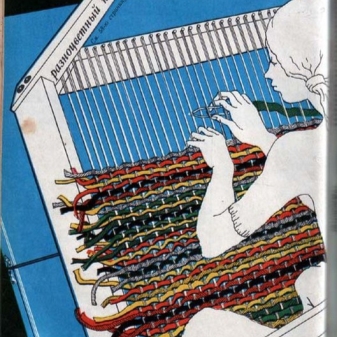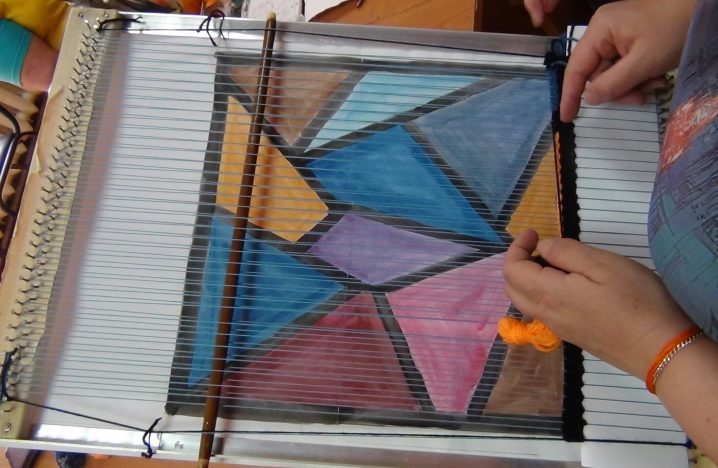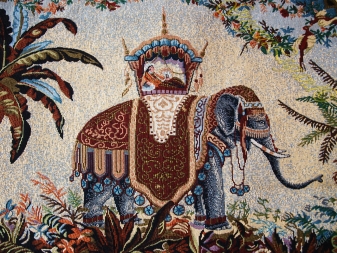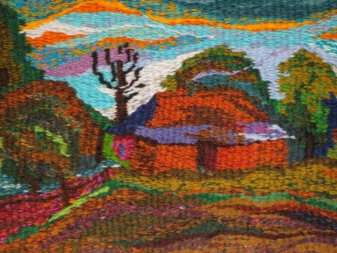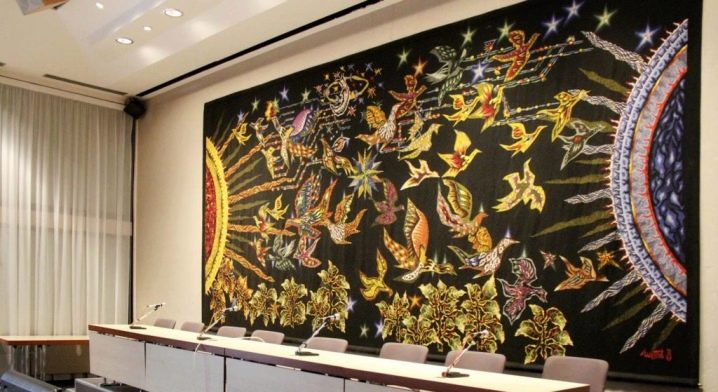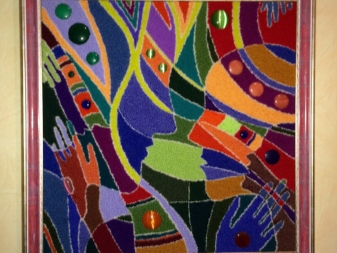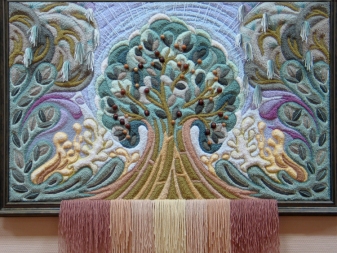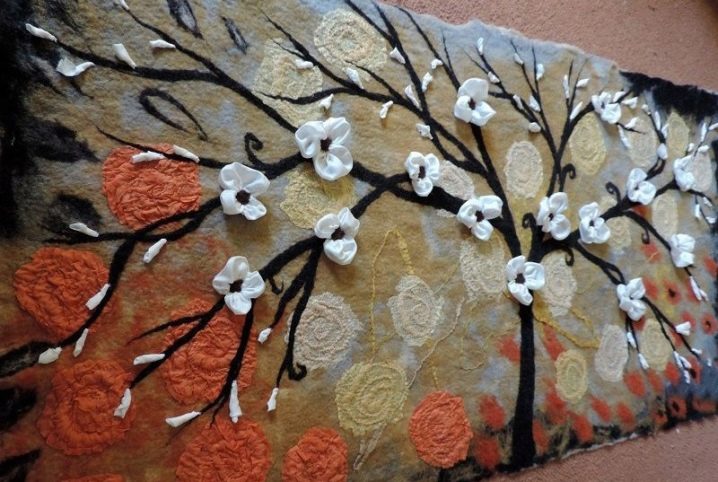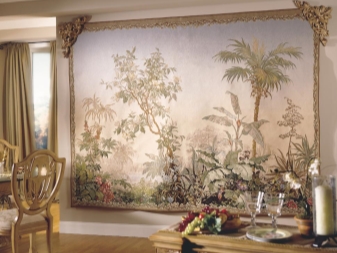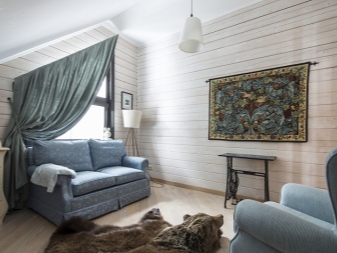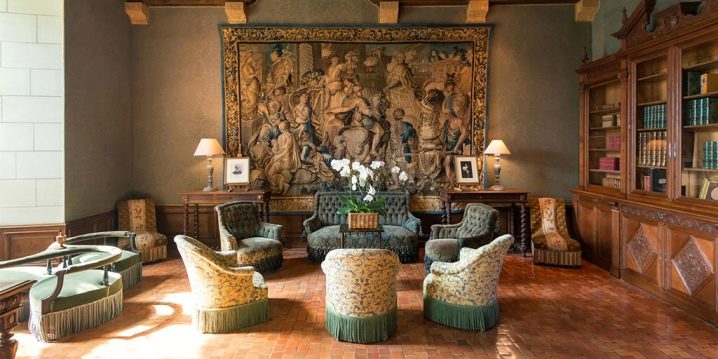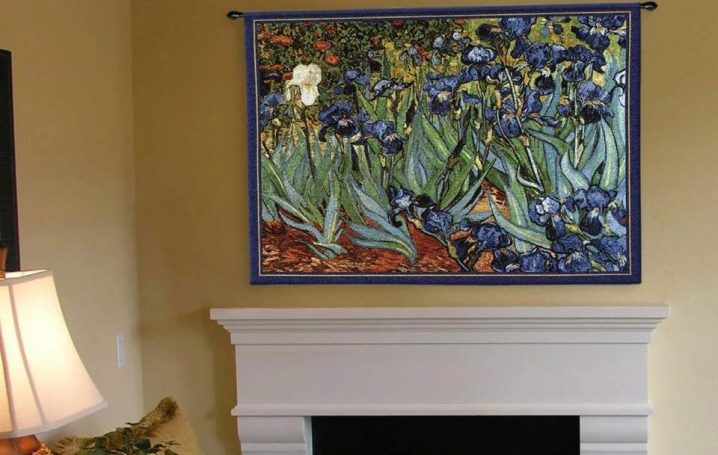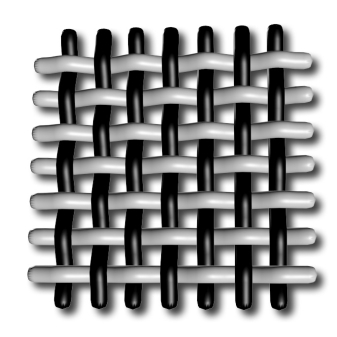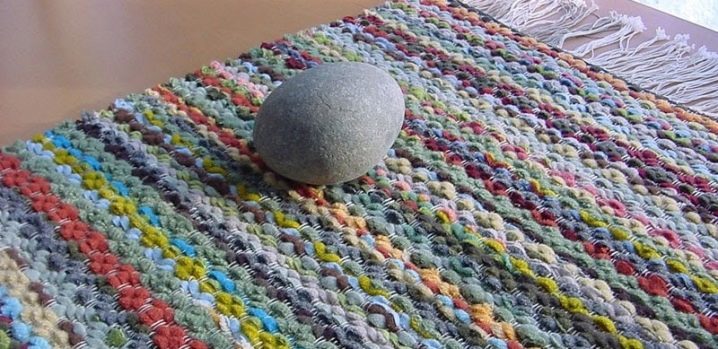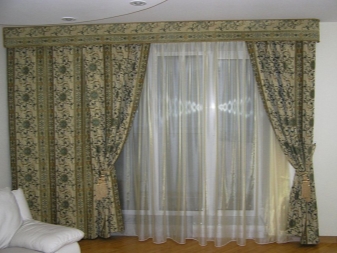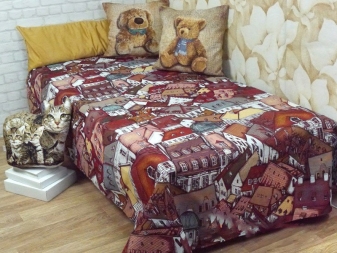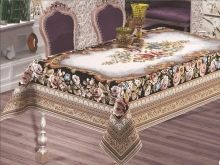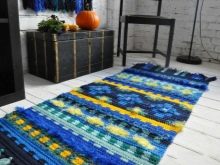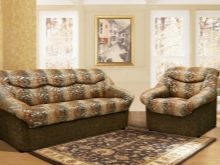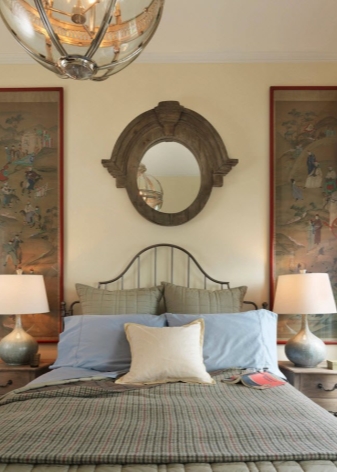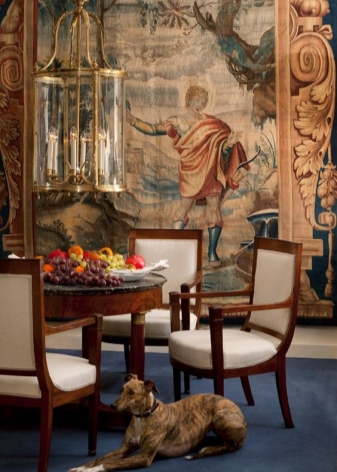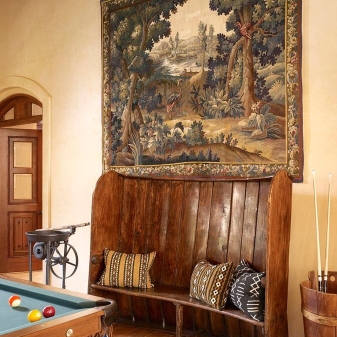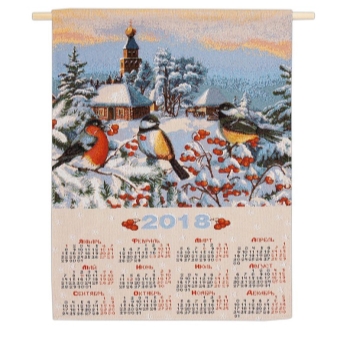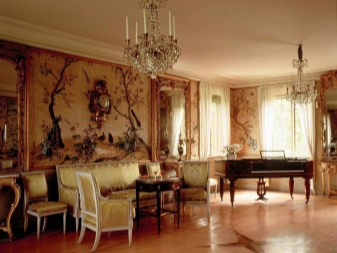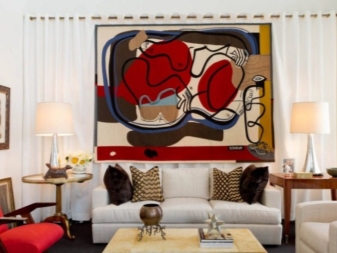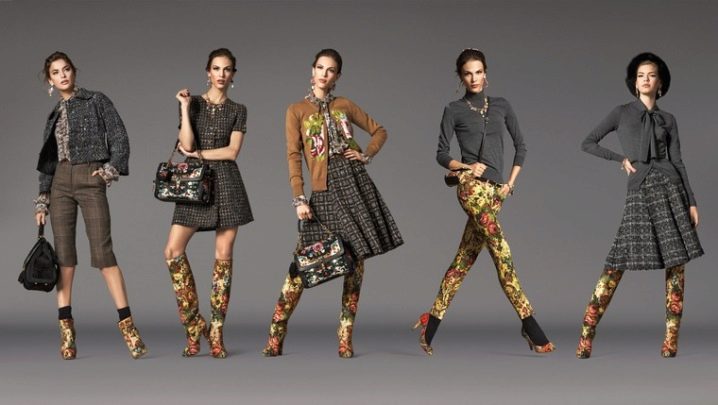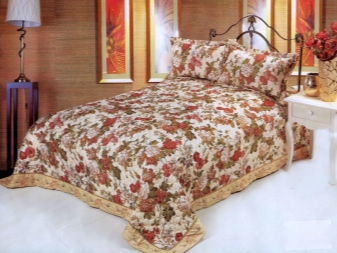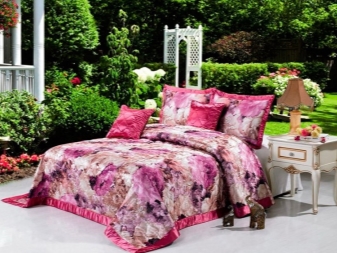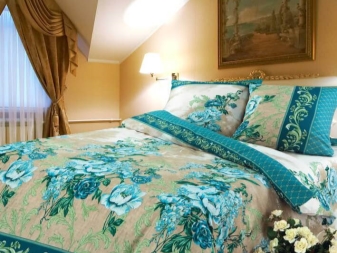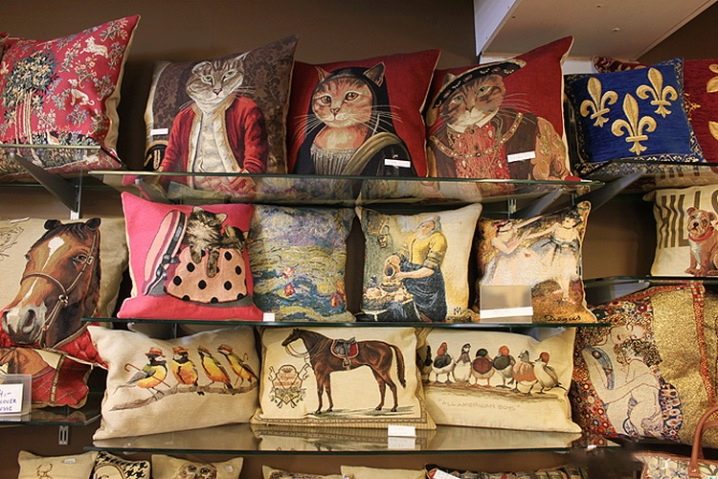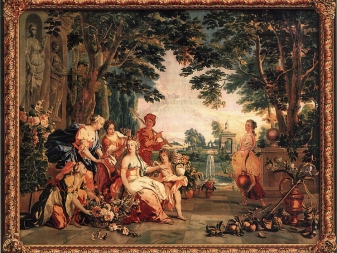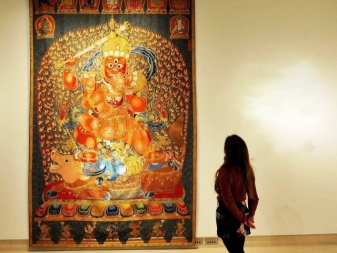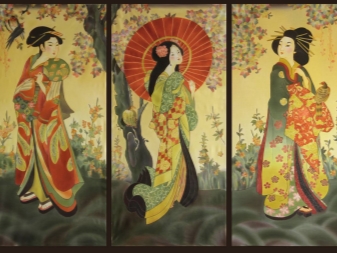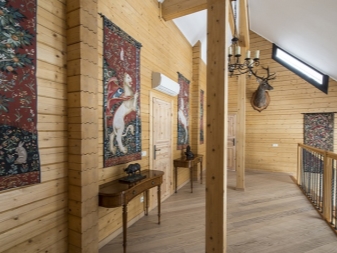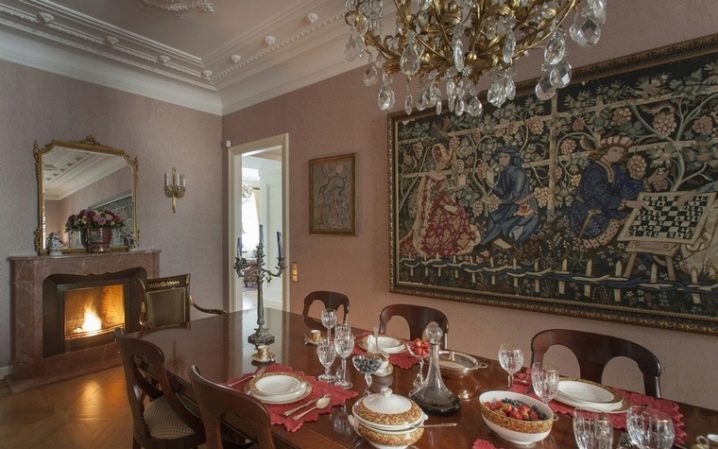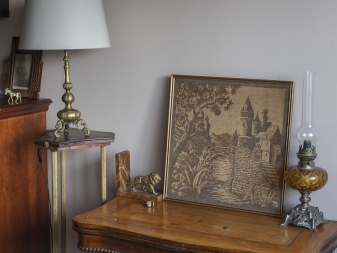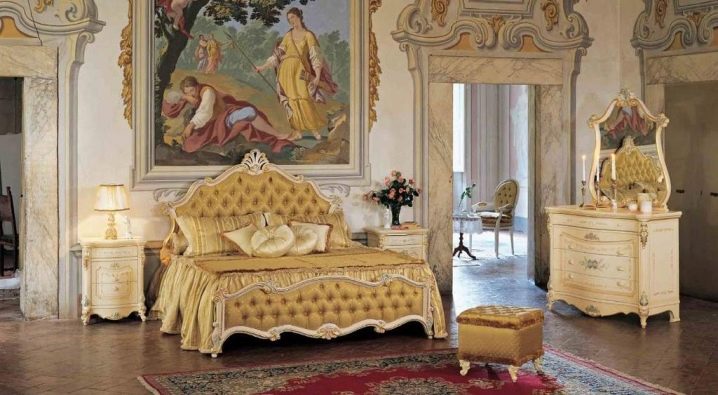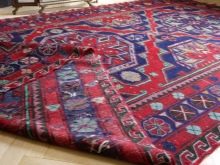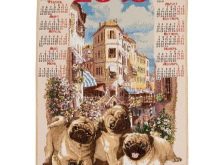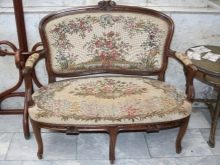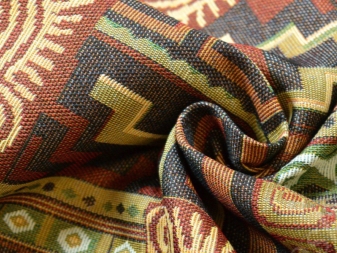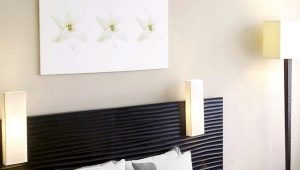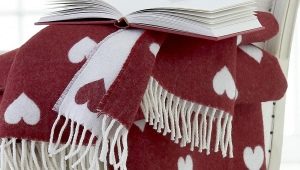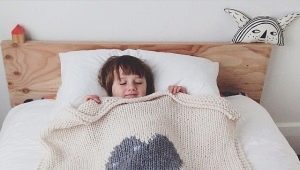Tapestries: features and use in the interior
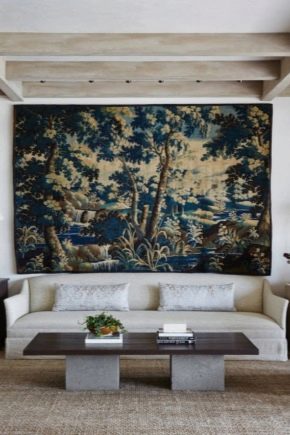
Thanks to the unusual look and texture, tapestries very often attract the attention of designers and customers. To understand all the intricacies of creating an interior and caring for such a product will help some knowledge about it.
What it is?
Tapestry, or tapestry is the result of one of the forms of applied art. The finished product has both utilitarian and decorative properties. In modern design, the tapestry is treated like a work of art, a painting. In the creation of paintings are not used brushes and paint, the material is purely woven.
Due to the various interweaving of colored threads, a unique work is created that is performed on a specific topic, for example, a love story or one of the moments of a summer hunt, and can also have an abstract meaning.
History of
The origins of the trellis making is very difficult to trace. This is due to the fact that many nations independently engaged in and developed weaving within their own ethnic group. The most ancient tapestries come from Egypt. In the tomb of Thutmosis IV (XV BC), a linen cloth depicting scarabs and lotuses was found, and in the tomb of Tutankhamen (XIV BC) a dress and gloves, created in the likeness of a trellis. But even such good reasons to assert that these are the very first tapestries are not proof of this.
Historians claim that the Egyptians adopted this type of weaving from the peoples of Mesopotamia, records of ancient authors testify to this.
In Homer's Odyssey poem there is a reference to burial objects made in the tapestry technique. This fact testifies to the existence of weaving in ancient Greece and Rome.
At the other end of the world, in pre-Columbian America, mainly in ancient Peru, during excavations, trellis elements were found, most of all in the use of relevant modern ideas about tapestries. Peruvians not only decorated walls with woven paintings, but also used them to hide from drafts.
Ancient tapestries from China were distinguished by sophistication and special subtlety. Chinese masters used motifs taken from nature to create such elements of decor and clothing: unusually beautiful and exotic flowers, intertwined stems, and subtle landscapes. The art of this type of weaving from the Chinese peoples was adopted by Japan.
The tapestries gained wide popularity in Europe in the Middle Ages thanks to the mass crusade campaigns. Tapestries were especially valuable trophies and were highly valued.
Each nation had its own name of a tapestry: among the Greeks - “tapes”, in Italy - “Arezzi”, in Latin - “tapetum”. The word "tapestry" comes from France. In the 17th century, the royal manufactory of Tapestries opened, giving the name of its products.
At what experts say that only products of this factory can rightly be called "tapestries", while the rest are trellis.
It is worth noting that the scope of woven art is large and diverse. In addition to utilitarian and decorative properties, the tapestries are used to this day as upholstery for upholstered furniture, as elements of clothing or clothing in general (to create traditional outfits), as a replacement for classical icon painting, in a heraldic sense, and so on.
Manufacturing Technique
Traditionally, tapestries are created by hand. The process is reminiscent of weaving lint-free carpets, but it is more laborious and laborious, since the threads are much thinner, and the design is very detailed.
Initially, as a basic tool for creating a product, there was an ordinary frame, on which the warp threads were tensioned. To achieve the desired tension, nails hammered into the frame or evenly made special holes on the inside of the frame were used. A weft thread, wound on a bobbin or simply wound into a ball, is inserted between the warp threads, and after completing the row, is nailed with the fingers or with the help of a special beater.
More technical is the process using the machine. Its feature is that the machine can be placed both horizontally and vertically.
The master works on a sketch drawn on cardboard, and the size of the pattern and color completely coincides with the size and colors of the future trellis. But in spite of the fact that the weaver has to copy another work, he must have artistic instincts, be able to maintain color reproduction, to understand the intricacies of the image of light and shade,to represent how the finished woven piece will look like in order to select the desired thread in this series.
Large manufactories producing products on a global scale even organized art schools at their factories, which increased the quality of the finished products.
Since the process of creating this canvas is very time consuming and time consuming, up to 5-6 people can work on one trellis. Thus, one work is divided into several parts, which are then sewn together with a silk thread. One could understand this by looking at the seamy side: the seams were present.
Due to the large number of techniques it is possible to achieve various effects in the manufacture of the trellis. If, in the classical form, the warp threads are invisible, then in the modern version the masters can deliberately leave them on the front side of the picture. This technique was called rep, because the fabric takes a certain relief ribbed, which in French sounds like "reps".
Modern tapestry as an element of decor over the past decade has undergone great changes. This type of decoration of walls and various surfaces has become so popular in recent years that it simply had to become more accessible among the masses.
A completely woven product is an expensive pleasure, few can afford such delicacy. But the non-woven tapestry is very simple in execution, but it looks almost indistinguishable from the original.
Such a product is created with the help of a special display of the pattern with colored fibers or threads on the base. The product can hardly be called a tapestry in the traditional sense of the word, because “tapestry” is, above all, a woven canvas. However, the lined pattern has a woven texture and a very detailed and dynamic pattern.
Chinese masters invented another kind of non-woven tapestry. Panels are made without the use of knitting needles or hooks. All items are made of cardboard, on which yarn is subsequently wound. The master glues ready-made parts onto a fully wrapped base and frame, creating a composition.
Advantages and disadvantages
The advantages of a tapestry as a decor element are many. This picture looks very elegant, I want to look at it, remember each element, it magically attracts attention, creates comfort and a warm atmosphere in the house.
In a practical sense, such an acquisition will also be useful.The cloth has antistatic properties and does not attract dust, the fabric holds its shape well, does not warp or deform, and is easy to clean. Tapestries are suitable for any style in the interior, the main thing is to correctly choose the picture.
The disadvantages include a relatively large weight, which does not allow the use of equipment in relation to casual wear. At home, it is better not to wash and iron the product, as this may affect its appearance.
Main characteristics
Every nation had its own way of weaving tapestries. They differ in texture and material used. At present, to create a certain relief, the master selects any necessary method of manufacture.
- Plain weaving is considered the most common and has a wider use among craftsmen. To create an item, a weft thread staggered through the warp threads. Thus, the first pass overlaps the even threads of the warp, and the second overlaps the even threads.
- Egyptian weaving creates a duck like a regular pigtail. This effect is due to the fact that the thread that creates the pattern is knitted around the warp and knotted around the warp.This process is one of the most time consuming. Often, only certain elements are woven in this way.
- Greek weaving does not form a dense, loose surface. To knit a row, 2 or 3 weft threads are required, which are interwoven with the warp threads as a regular braid.
More sophisticated in the way of weaving: binding, sumach weaving, twill, giordes, hay. Each differs in density, relief, the possibility of manufacturing elements of varying complexity. Each method has its own material.
Wool, cotton, silk threads can either emphasize relief, or vice versa, to create a perfectly flat surface.
Fabric types
In the modern view, tapestry as a material is a variation of jacquard fabric. Jacquard is a large-knit fabric of complex or simple weaving of more than 24 threads, which is distinguished by high density, durability, complexity of the pattern, versatility of textures, colors and patterns. The base is usually linen, but the weft threads are silk, woolen or synthetic.
Thin, elegant, with detailed drawing tapestries are obtained from silk threads.Clothing, curtains, bedspreads are sewn from such material.
For utilitarian purposes, such as protection against drafts, suitable products made of wool. Wool threads are the most convenient and less labor-intensive material for weaving, but very heavy. It produces carpets on the walls and on the floor. Upholstery upholstered furniture is best made from cotton materials. Tablecloths and linens are made from flax. Metallic threads are used for decorative purposes, give shine and shimmer in the light.
Fashionable patterns and colors
Since these products have a centuries-old history and are considered an attribute of antiquity, in our time it is considered fashionable to emphasize this property. Proceeding from this, the themes of the tapestry drawing reflect moments not related to modern life - these are illustrations for a medieval book or a woven reproduction of a work of the Renaissance, an image of a scene of hunting in Russia.
Such canvases, even those made in modern factories, will make one think that perhaps this tapestry had once been hung in the palace of the king of France. The interior will immediately acquire a “story”.
Another "classic" in the performance of tapestries is the image of nature on the canvases.Tapestries with deer, bears, horses and simply gorgeous landscapes are a more democratic option than, for example, the classic battle scenes.
For romantic persons, preferring such styles as chebbi-chic, the flowers on tapestries will perfectly complement the interior design. Chic peonies, roses, hibiscus - the main attributes of the style of antique. More infantile scenes are footage from anime films or images of cute cats and puppies on canvases. Woven calendars - an original way to find out the date and emphasize the stylistic orientation of the interior.
In the historical sense, tapestries do not have too bright colors. Previously, there were no pigments capable of creating, for example, a rich lime color or sky blue, all shades muted, soft, but deep. Starting from this, choose a tapestry for classic and minimalist interiors in such colors. In bright pop art designs with colors you can experiment. For the plot here is sure to find food for thought.
Areas of use
In the modern world, the use of tapestries has narrowed somewhat.Because of their gravity, the trellis is not suitable for the full production of clothing, although in ancient times woven robes and dresses were considered traditional clothing in Japan and China. Designers in the world of high fashion continue to create haute couture outfits in this technique, but hardly such models will reach the ready-to-wear collections.
But the elements - processing the edges of sleeves or lapels on a jacket, can be found in everyday life.
In the interiors of their wider application. From jacquard fabric sew upholstery for furniture, pillowcases, bedspreads. If we talk about the ancient uses of the tapestry, it is enough to recall Homer's Odyssey, in which Penelope weaved a shroud for her father-in-law, as housing construction technologies were low, and woolen carpets were made to hide from drafts and cold. For kings during travels and military campaigns, entire tapestry tents were prepared.
Top manufacturers
There are many weaving factories specializing in the production of tapestries or having one of the directions associated with them, both in Russia and around the world.
The city of Ivanovo is famous for the manufacture of various fabrics.Ivanovo lanes are used for the manufacture of pillowcases, paintings, murals, curtains, bedspreads, napkins, bags, calendars. Designers, artists, design engineers and workers are responsible for the smooth operation of the machines. All equipment is predominantly made abroad, and experience in creating drawings is taken over from masters from China, Turkey and Italy.
You can buy Ivanovo tapestries at exhibitions of Ivanovo products, in retail outlets, as well as through online stores.
Since the end of the fifteenth century, Flanders took the lead for three centuries ahead in the production of top-class tapestries. The main centers were the cities of Belgium - Bruges and Antwerp, and a little earlier Arras. The main difference between the Belgian tapestries - the introduction of the threads of "Cypriot gold" into the fabric - twisted silk or flax entwined with gold or silver wire. The product includes precious metals, which gives a special price to the canvas.
To this day, the Belgian tapestries are unique and are considered an expensive acquisition.
Along with them, French and Italian products have incorporated the traditional aspects of weaving, compatible with the latest technologies.European factories offer panels with medieval motifs, as well as ready to create a reproduction of contemporary artists.
From ancient times to this day, France, Belgium and Italy are considered to be classic manufacturers of tapestries.
For unique and colorful solutions it is recommended to turn your attention to the East. Here handicrafts are represented by Indian, Chinese and Japanese masters. Topics tapestries from India - traditional ornaments, images of elephants, the god Shivva and other deities.
Chinese tapestries also reflect elements of history and tradition. Many motifs are devoted to the image of nature, amazing and beautiful flowers, significant events.
Japanese products are striking in their colorful. A frequent theme is Japanese women in national costumes with all sorts of cultural paraphernalia, branches of blossoming sakura, landscapes, architectural elements.
Application in the interior
When it comes to tapestries, the first thing we present is a beautiful woven fabric on the wall. Such a picture can be hung in a regular apartment, but in a large country house it will look much more harmonious.Moreover, more than one century ago, ensembles of 3, 5 or 6 tapestries, united by one theme, were invented by manufacturers. This solution allows you to place on the walls a whole story: about knightly deeds; o big but miserable love; about hikes and great conquests.
This makes it possible to fill the room with meaning, to give depth to the design concept.
The size of the wall trellis depends on the size of the wall and interior design. A large wall-mounted tapestry looks powerful and luxurious. The decoration of the wall itself in such a case should be modest, monotonous, so that all the attention was captured by the gorgeous canvas.
Monochrome tapestries decorated with metal threads can even fit into high-tech interiors, although they are not considered a traditional element of this style. Miniatures in wooden frames will fit into a small room. This is a great choice for creating comfort in the bedroom. Etudes in the style of Provence complement the interior of the kitchen, if they competently combine with the drape of chairs, curtains or pillows.
Tapestries are simply created for styles such as Baroque and Rococo. Historically, it has happened that the widespread use of trellis falls at the heyday of these styles.Beautiful canvases depicting nature, flowers, androgynous celestial beings, angelic apparitions, love scenes will complement the luxury of architectural forms.
Wool carpets on the floor, made in the tapestry technique, combine lint-free and tufted elements. The basis of them is mostly smooth, but the drawing is made in the form of flowers and curls of soft nap. This design has antistatic properties, less attracts dust, and the product is light and thin.
In addition, jacquard fabric is often used for furniture upholstery. The ideal option is furniture made of solid wood, draped with tapestry fabric with a floral motif. Special lovers of woven products can pamper themselves for the New Year holiday and buy a tapestry in the form of a calendar.
Care Tips
Tapestry is first of all a fabric, and from this we must make a start in matters of caring for the product. Due to the fact that in the manufacture of products used natural yarn, washing machine is strictly contraindicated. But it is better not to wash the trellis by hand. This may lead to deformation of the material, the product may "sit down" or, on the contrary, stretch.
At home, it is best to use dry cleaning with a brush and vacuum cleaner. For stubborn stains use dry cleaning services.
The old antique canvas is better to give for restoration. There are not very many masters involved in the restoration of tapestries, but a product that requires such careful attention does not require neglect. Restorers know the specifics of working with such a fragile thing and will not allow it to deteriorate and lose value.
For more information on the use of tapestry in a modern interior, see the following video.
